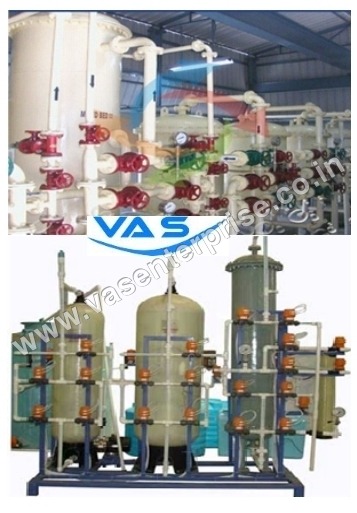Desalination Plant
Desalination Plant Specification
- Usage & Applications
- Municipal, Industrial, Hotels, Resorts, Ships
- Feature
- Corrosion Resistance, Easy Operation, Energy Efficient
- Efficiency (%)
- >97%
- Frequency
- 50/60 Hz
- Water Out Conductivity
- < 30 S/cm
- Pump Type
- High Pressure Pump
- Noise Level
- < 75 dB
- Technology
- Reverse Osmosis (RO)
- Material
- Stainless Steel / FRP
- Drive Type
- Electric Motor
- Water Source
- Sea Water / Brackish Water
- Power Source
- Electric
- Volume
- Customizable
- Automatic Grade
- Automatic
- Purity Level
- Up to 99.5%
- Capacity
- 5,000 to 500,000 LPD
- Installation Type
- Containerized / Skid Mounted
Desalination Plant Trade Information
- Minimum Order Quantity
- 01 Set
- Delivery Time
- 12 Week
- Main Export Market(s)
- Middle East, Africa, Asia
- Main Domestic Market
- All India
About Desalination Plant
Desalination Plant refers to the method of eliminating amount of minerals and salt from the saline water. Desalination process is applied to make the saline water fresh that can be further used for irrigation and human consumption. It is considered as the highly economical way of attaining pure water for human use. Apart from, recycling wastewater, Desalination Plant is also useful for some rainfall independent water sources.
Features:
- Separate salts from water
- Use less energy than thermal distillation
- Energy intensive
Further Details:
We are manufacturer and exporter of desalination plant based on ion exchange technology. It comprises two vessels filled with strong base cation exchange resin and strong acid anion exchange resin. They are available in a range of diameters.
Mix Bed Plant is based on ion exchange technology. It contains single vessel filled with cation exchange resin and anion exchange resin. This system works as a polisher unit and it is giving best quality of water. System would produce IP grade water.
VAS offer DM & MB plant for various sectors:
-
Pharmaceutical
-
Power plant
-
Oil & Gas
-
Chemical industries
-
Textile industries
Advanced Auto-Control & Reliable Performance
Equipped with a PLC-based automatic control system, this desalination plant ensures precise and continuous operation. Routine processes like flushing and cleaning are managed automatically, minimizing manual intervention and reducing operator workload. The design supports long-term durability and consistently high water quality.
Comprehensive Pretreatment & Effective Filtration
Pretreatment stagesincluding sand, carbon, and micron cartridge filtersremove suspended solids, organics, and fine particulates. This safeguards the reverse osmosis membranes and extends their lifespan, resulting in stable performance and lower maintenance requirements.
Versatile Applications & Customization
With a customizable capacity from 5,000 to 500,000 LPD, the plant adapts to a range of applications, from municipal and industrial uses to hotels, resorts, and ships. Its robust construction and containerized or skid-mounted options ensure easy installation in varied environments.
FAQs of Desalination Plant:
Q: How does the PLC-based auto control system improve operation of the desalination plant?
A: The PLC-based auto control system automates key processes like start-up, shutdown, and cleaning cycles, ensuring consistent water quality and operational efficiency. It reduces the need for constant manual supervision, enhancing reliability and safety.Q: What is the process for converting sea or brackish water into drinking water with this plant?
A: The plant uses a multi-stage pretreatment processsand, carbon, and micron cartridge filtrationfollowed by high-pressure reverse osmosis. This combination effectively removes impurities, salt, and contaminants, producing water that meets IS 10500 drinking standards.Q: Where can this desalination plant be installed and used effectively?
A: It is suitable for diverse applications including municipal water supply, industrial processes, hotels, resorts, and ships. The plants containerized or skid-mounted configuration allows for flexible installation in both permanent and remote locations.Q: What are the benefits of the automatic flushing and CIP cleaning system?
A: The automatic flushing and CIP (Clean-In-Place) system helps prevent membrane fouling by regularly removing accumulated deposits. This maintains high performance, reduces downtime, and extends the operational life of the plant.Q: When is maintenance required for the desalination plant, and how is it managed?
A: Routine maintenance intervals depend on feed water quality and operational usage. However, the plants automated controls and cleaning systems significantly reduce the frequency and complexity of manual maintenance tasks, ensuring easier upkeep.Q: What are the advantages of SS 304 and FRP construction materials in the desalination plant?
A: Stainless Steel 304 and FRP (Fiber Reinforced Plastic) materials provide excellent corrosion resistance, especially in harsh coastal environments. This enhances the plants durability, ensuring a design life exceeding 15 years.

Price:
- 50
- 100
- 200
- 250
- 500
- 1000+
 |
VAS ENTERPRISE
All Rights Reserved.(Terms of Use) Developed and Managed by Infocom Network Private Limited. |

 Send Inquiry
Send Inquiry
